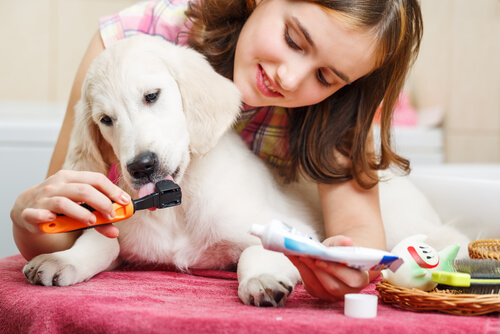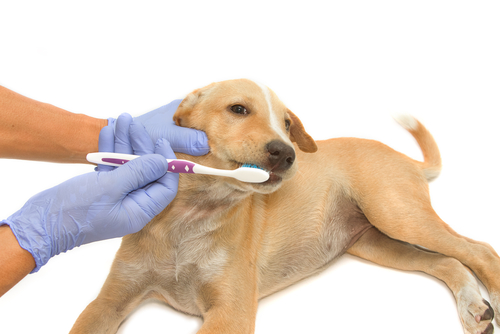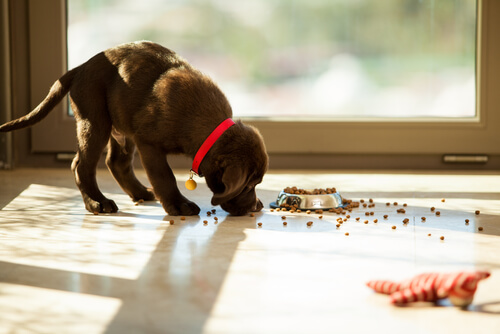How to Take Better Care of Your Dog's Teeth

Pets do not know how to brush or floss their teeth, much less how to use mouthwash. . . That is exactly why owners must take care of their dog’s teeth and thus avoid certain common diseases like decay, plaque or halitosis.
Taking Care of Your Dog’s Teeth Is a Daily Responsiblity
Keeping up with your pet’s dental hygiene is essential in preventing the onset of bad breath or even more serious problems, such as losing bad teeth.
As their owner, you are responsible for every aspect of your pet’s well-being. That’s why, when taking the first step towards better a oral hygiene routine for your furry friend, you need to being paying more attention to their teeth and mouth, since dental diseases are very common. Fortunately, there are several ‘steps’ that you can take to establish a healthy oral care routine for your pet.
To begin with, gently separate your dog’s jaws, as this will not cause them to feel threatened. Check for any indications of oral problems such as, for example, yellow spots on their teeth, bleeding, red gums, loose or missing teeth, bad breath and excessive salivation.

Also, be aware of any changes in your pet’s eating habits. For example: difficulty or pain while chewing, or squeezing their muzzle with their front paws. It’s essential for you to take them for a check-up with the vet. Then, the vet will be able to help your dog.
Tips For Taking Care of Your Dog’s Teeth
It is often said that it’s “better to prevent than to cure.” Well, this is absolutely true. Add these habits to your routine. And, you will noticeably reduce your pet’s dental problems.
1. Brush Their Teeth
First of all, you have to remember that dog’s anatomies are very different from ours and, therefore, you need a special toothbrush and toothpaste—which you can get at the veterinary or in a pet store—to avoid additional problems.
The brush adapts to the needs of the animal’s mouth and the toothpaste will not cause them indigestion or stomach pain. The best time to start brushing your pet’s teeth is before they turn four months old, since they will see it as a game and will have that mindset for the rest of their life.

If your dog is already older than this you can still start today, but do so carefully and slowly until they get used to it. They should see it as something fun, and not as a negative experience.
2. Give Them Dry Food
Your dog’s food, among other things, serves to act as a toothbrush, and to remove any plaque is accumulated between their teeth and fangs. Chewing on food of a certain texture keeps your pet’s mouth healthy and reduces bad breath.
Therefore, if you are giving your pet wet food for humans, we recommend that you try feeding them dry food at least twice a week. And do not forget to buy one that is good quality so that it can provide all the necessary nutrients to strengthen your dog’s teeth.

At the same time, though, be very careful about feeding your dog bones, such as those from chicken or beef. They can splinter and get stuck in their gums and throats, which will inevitably cause injuries, bleeding and pain.
3. Choose Their Toys Wisely
In pet stores or at the vet’s office, you can buy your dog treats. These serve as rewards when your dog behaves well. And, they are excellent edible toys and are good for their oral health. They are made with ingredients similar to those in dog food, which help to eliminate plaque and bad breath.
Additionally, you can buy your pet toys made out to other non-edible materials. However, make sure the toys are not harmful to their teeth.
The most suitable toys are made of natural rubber or Nylon. Why? Because they favor the removal of tartar and, at the same time, strengthen their teeth and gums.
Pets do not know how to brush or floss their teeth, much less how to use mouthwash. . . That is exactly why owners must take care of their dog’s teeth and thus avoid certain common diseases like decay, plaque or halitosis.
Taking Care of Your Dog’s Teeth Is a Daily Responsiblity
Keeping up with your pet’s dental hygiene is essential in preventing the onset of bad breath or even more serious problems, such as losing bad teeth.
As their owner, you are responsible for every aspect of your pet’s well-being. That’s why, when taking the first step towards better a oral hygiene routine for your furry friend, you need to being paying more attention to their teeth and mouth, since dental diseases are very common. Fortunately, there are several ‘steps’ that you can take to establish a healthy oral care routine for your pet.
To begin with, gently separate your dog’s jaws, as this will not cause them to feel threatened. Check for any indications of oral problems such as, for example, yellow spots on their teeth, bleeding, red gums, loose or missing teeth, bad breath and excessive salivation.

Also, be aware of any changes in your pet’s eating habits. For example: difficulty or pain while chewing, or squeezing their muzzle with their front paws. It’s essential for you to take them for a check-up with the vet. Then, the vet will be able to help your dog.
Tips For Taking Care of Your Dog’s Teeth
It is often said that it’s “better to prevent than to cure.” Well, this is absolutely true. Add these habits to your routine. And, you will noticeably reduce your pet’s dental problems.
1. Brush Their Teeth
First of all, you have to remember that dog’s anatomies are very different from ours and, therefore, you need a special toothbrush and toothpaste—which you can get at the veterinary or in a pet store—to avoid additional problems.
The brush adapts to the needs of the animal’s mouth and the toothpaste will not cause them indigestion or stomach pain. The best time to start brushing your pet’s teeth is before they turn four months old, since they will see it as a game and will have that mindset for the rest of their life.

If your dog is already older than this you can still start today, but do so carefully and slowly until they get used to it. They should see it as something fun, and not as a negative experience.
2. Give Them Dry Food
Your dog’s food, among other things, serves to act as a toothbrush, and to remove any plaque is accumulated between their teeth and fangs. Chewing on food of a certain texture keeps your pet’s mouth healthy and reduces bad breath.
Therefore, if you are giving your pet wet food for humans, we recommend that you try feeding them dry food at least twice a week. And do not forget to buy one that is good quality so that it can provide all the necessary nutrients to strengthen your dog’s teeth.

At the same time, though, be very careful about feeding your dog bones, such as those from chicken or beef. They can splinter and get stuck in their gums and throats, which will inevitably cause injuries, bleeding and pain.
3. Choose Their Toys Wisely
In pet stores or at the vet’s office, you can buy your dog treats. These serve as rewards when your dog behaves well. And, they are excellent edible toys and are good for their oral health. They are made with ingredients similar to those in dog food, which help to eliminate plaque and bad breath.
Additionally, you can buy your pet toys made out to other non-edible materials. However, make sure the toys are not harmful to their teeth.
The most suitable toys are made of natural rubber or Nylon. Why? Because they favor the removal of tartar and, at the same time, strengthen their teeth and gums.
This text is provided for informational purposes only and does not replace consultation with a professional. If in doubt, consult your specialist.







